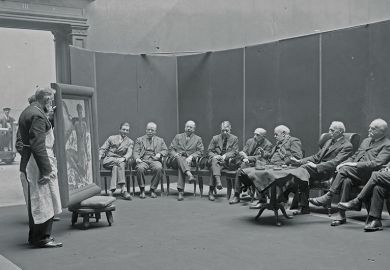Teaching students in smaller classes had no impact on how universities scored in the UK’s teaching excellence framework, despite the government’s interest in making this part of future metrics for the exercise, an analysis shows.
There was also no link between the proportion of staff who held a teaching qualification accredited by the Higher Education Academy and how well an institution fared in the assessment, according to researchers at Cranfield University who sought to examine whether outstanding performance on two of the sector’s most accepted measures of educational standards had any bearing on institutional outcomes.
Authors Richard Wilding and Emel Aktas found that there was no correlation between staff-to-student ratios, which they treat as a proxy for class sizes, and the TEF awards announced in June. For example, De Montfort University claimed a gold award with a student-to-staff ratio of 19:1, whereas Soas, University of London (11:1) achieved bronze, says the study, which used data from the Higher Education Statistics Agency to calculate the ratios.
The findings come as the government plans to pilot a “teaching intensity” metric in the subject-level iteration of the TEF, which would measure contact hours and class sizes.
Professor Wilding and Dr Aktas also discovered no correlation between the proportion of staff who have teaching qualifications and a university’s TEF award. For instance, 90 per cent of teaching staff at the University of Huddersfield are recognised as HEA fellows, having undertaken teacher training recognised by the organisation, while only 3 per cent of academics at the University of Cambridge can claim the same award; yet both institutions received gold awards in the TEF.
Conversely, 83 per cent of York St John University teaching staff are HEA fellows – the third-highest proportion in the UK, according to data for 2014-15 published by Hesa – yet the institution received a bronze award, as did the London School of Economics, where only 13 per cent of teaching staff possess an HEA award, the authors found.
The study is likely to spark further debate about the validity of the TEF’s results in advance of an independent review of the framework, which is set to take place in 2018-19 ahead of the potential introduction of subject-level results.
A Universities UK report released last month, which was based on responses from 83 of its members before the publication of the TEF results, found that only 2 per cent of institutions agreed that the framework would “accurately assess teaching and learning excellence”, whereas 73 per cent disagreed (25 per cent were neutral).
Asked what new metrics should be prioritised for inclusion in any future versions of the TEF, 43 per cent of respondents highlighted teaching qualifications – a more popular choice than longitudinal education outcomes (LEO) data on graduate earnings (cited by 27 per cent), which will be included in the future TEF.
Professor Wilding, Cranfield’s professor of supply chain strategy, told Times Higher Education that he was keen to take forward the debate on “what the TEF is actually measuring” and hoped that the analysis “opened up a lot more questions about the TEF for institutions”.
Register to continue
Why register?
- Registration is free and only takes a moment
- Once registered, you can read 3 articles a month
- Sign up for our newsletter
Subscribe
Or subscribe for unlimited access to:
- Unlimited access to news, views, insights & reviews
- Digital editions
- Digital access to THE’s university and college rankings analysis
Already registered or a current subscriber?








